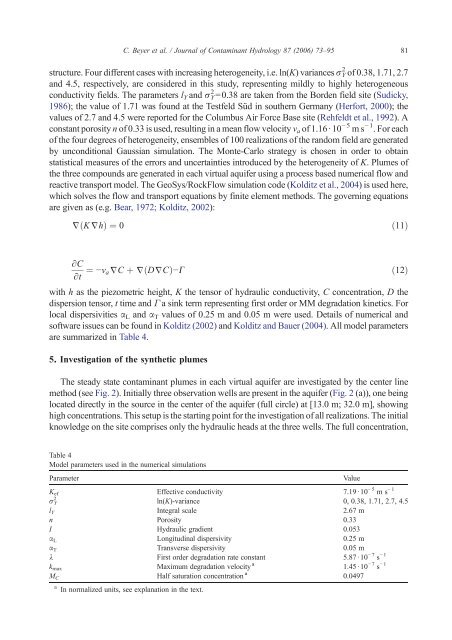Applied numerical modeling of saturated / unsaturated flow and ...
Applied numerical modeling of saturated / unsaturated flow and ...
Applied numerical modeling of saturated / unsaturated flow and ...
You also want an ePaper? Increase the reach of your titles
YUMPU automatically turns print PDFs into web optimized ePapers that Google loves.
structure. Four different cases with increasing heterogeneity, i.e. ln(K) variances σY 2 <strong>of</strong> 0.38, 1.71, 2.7<br />
<strong>and</strong> 4.5, respectively, are considered in this study, representing mildly to highly heterogeneous<br />
conductivity fields. The parameters lY <strong>and</strong> σY 2 =0.38 are taken from the Borden field site (Sudicky,<br />
1986); the value <strong>of</strong> 1.71 was found at the Testfeld Süd in southern Germany (Herfort, 2000); the<br />
values <strong>of</strong> 2.7 <strong>and</strong> 4.5 were reported for the Columbus Air Force Base site (Rehfeldt et al., 1992). A<br />
constant porosity n <strong>of</strong> 0.33 is used, resulting in a mean <strong>flow</strong> velocity va <strong>of</strong> 1.16·10 −5 ms −1 . For each<br />
<strong>of</strong> the four degrees <strong>of</strong> heterogeneity, ensembles <strong>of</strong> 100 realizations <strong>of</strong> the r<strong>and</strong>om field are generated<br />
by unconditional Gaussian simulation. The Monte-Carlo strategy is chosen in order to obtain<br />
statistical measures <strong>of</strong> the errors <strong>and</strong> uncertainties introduced by the heterogeneity <strong>of</strong> K. Plumes <strong>of</strong><br />
the three compounds are generated in each virtual aquifer using a process based <strong>numerical</strong> <strong>flow</strong> <strong>and</strong><br />
reactive transport model. The GeoSys/RockFlow simulation code (Kolditz et al., 2004)isusedhere,<br />
which solves the <strong>flow</strong> <strong>and</strong> transport equations by finite element methods. The governing equations<br />
are given as (e.g. Bear, 1972; Kolditz, 2002):<br />
jðKjhÞ ¼0 ð11Þ<br />
∂C<br />
∂t ¼ −vajC þ jðDjCÞ−C ð12Þ<br />
with h as the piezometric height, K the tensor <strong>of</strong> hydraulic conductivity, C concentration, D the<br />
dispersion tensor, t time <strong>and</strong> Γ a sink term representing first order or MM degradation kinetics. For<br />
local dispersivities αL <strong>and</strong> αT values <strong>of</strong> 0.25 m <strong>and</strong> 0.05 m were used. Details <strong>of</strong> <strong>numerical</strong> <strong>and</strong><br />
s<strong>of</strong>tware issues can be found in Kolditz (2002) <strong>and</strong> Kolditz <strong>and</strong> Bauer (2004). All model parameters<br />
are summarized in Table 4.<br />
5. Investigation <strong>of</strong> the synthetic plumes<br />
The steady state contaminant plumes in each virtual aquifer are investigated by the center line<br />
method (see Fig. 2). Initially three observation wells are present in the aquifer (Fig. 2 (a)), one being<br />
located directly in the source in the center <strong>of</strong> the aquifer (full circle) at [13.0 m; 32.0 m], showing<br />
high concentrations. This setup is the starting point for the investigation <strong>of</strong> all realizations. The initial<br />
knowledge on the site comprises only the hydraulic heads at the three wells. The full concentration,<br />
Table 4<br />
Model parameters used in the <strong>numerical</strong> simulations<br />
Parameter Value<br />
Kef Effective conductivity 7.19·10 − 5 − 1<br />
ms<br />
σY 2<br />
ln(K)-variance 0, 0.38, 1.71, 2.7, 4.5<br />
lY Integral scale 2.67 m<br />
n Porosity 0.33<br />
I Hydraulic gradient 0.053<br />
αL Longitudinal dispersivity 0.25 m<br />
α T Transverse dispersivity 0.05 m<br />
λ First order degradation rate constant 5.87·10 − 7 − 1<br />
s<br />
kmax<br />
Maximum degradation velocity a<br />
1.45·10 − 7 − 1<br />
s<br />
MC<br />
C. Beyer et al. / Journal <strong>of</strong> Contaminant Hydrology 87 (2006) 73–95<br />
Half saturation concentration a<br />
a In normalized units, see explanation in the text.<br />
0.0497<br />
81

















